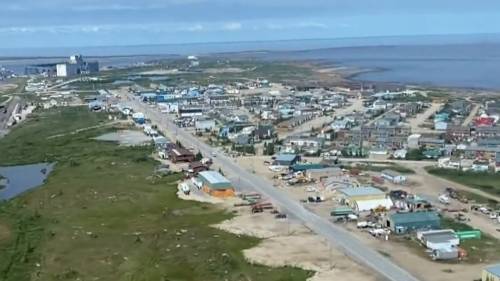Walking along Churchill’s ice-crusted harbor, the transformation is unmistakable. Just five years ago, this remote Manitoba port town faced economic collapse after its rail line washed out and shipping operations ground to a halt. Today, cargo vessels navigate the Hudson Bay waters with increasing frequency, carrying Canadian grain to markets once considered impractical through this Arctic gateway.
“We’re seeing interest from places we never imagined before,” explains Darren Kowalchuk, operations manager at the Port of Churchill. “Asian markets, particularly Japan and South Korea, are exploring this northern passage as a legitimate alternative to traditional shipping lanes.”
This renewed vitality comes at a critical moment as the global trade landscape undergoes tectonic shifts. President Trump’s administration has implemented sweeping tariffs affecting Canadian exports through conventional southern routes, prompting businesses to reconsider the Churchill option despite its shorter seasonal window and challenging Arctic conditions.
The port’s resurrection began when Arctic Gateway Group acquired the facilities in 2018, followed by substantial federal investments to restore the rail line. What once seemed like a regional infrastructure project has evolved into a strategic national asset as Canada seeks trade diversification amid increasing economic nationalism from its largest trading partner.
Data from Transport Canada indicates a 47% increase in tonnage shipped through Churchill between 2021 and 2023, with projections suggesting continued growth as infrastructure improvements expand the port’s operational capacity. The federal government recently announced an additional $178 million investment package aimed at modernizing port facilities and extending the shipping season through enhanced ice management.
Beyond grain exports, Churchill now handles fertilizer, manufactured goods, and limited natural resources. The economic ripple effects have revitalized this community of 900 residents, previously known primarily for polar bear tourism.
“People are moving back. Young families are staying,” says Mayor Mike Spence, who has advocated tirelessly for the port’s development. “We’re seeing housing construction for the first time in decades and businesses reopening on Kelsey Boulevard.”
The Churchill route offers compelling advantages for certain Canadian producers. Shipping distances to European markets are approximately 1,000 kilometers shorter than from Thunder Bay through the St. Lawrence Seaway. For prairie grain producers, rail distances to Churchill are substantially shorter than to Vancouver or Montreal.
James Richardson International, one of Canada’s largest grain handlers, has increased shipments through Churchill by 38% since 2021. “The economics increasingly make sense, especially with southern bottlenecks and rising fees at congested ports,” notes company spokesperson Andrea Thompson. “The savings can reach $15 per tonne for some prairie producers, which creates meaningful margins in the grain business.”
Climate change paradoxically works both for and against Churchill’s prospects. Melting sea ice extends the shipping season, potentially from July through November rather than the traditional August-October window. However, the same environmental shifts create unpredictable weather patterns and infrastructure challenges along the 1,000-kilometer Hudson Bay Railway connecting the port to southern Manitoba.
Indigenous communities along the rail corridor have become essential partners in this economic revival. The Missinippi Rail consortium, representing several First Nations, holds substantial ownership in the Arctic Gateway Group operating the port and railway.
“This isn’t just about shipping goods,” explains Fox Lake Cree Nation Chief Morris Beardy. “It’s about creating sustainable economic opportunities in a region where they’ve been historically limited. Our young people are training as rail technicians, logistics specialists, and port operators.”
International geopolitics add another dimension to Churchill’s emergence. Russia’s Arctic ambitions and control over the Northern Sea Route have prompted Canadian officials to reassess Arctic sovereignty and shipping capabilities. The Churchill corridor represents one of North America’s few functional deep-water Arctic ports.
Defense analysts note the strategic significance extends beyond commercial shipping. “Churchill provides essential maritime access in a region where climate change is rapidly altering security dynamics,” explains Heather Nicol, professor of Arctic security studies at Trent University. “The infrastructure supporting commercial activity simultaneously enhances capacity for monitoring and response in Canada’s northern waters.”
While enthusiasm grows, significant challenges remain. Insurance costs for vessels navigating Hudson Bay remain substantially higher than for traditional shipping lanes. Environmental groups express concern about increased marine traffic in sensitive Arctic ecosystems. The seasonal nature of operations creates boom-and-bust employment patterns challenging to community stability.
Yet for communities across Manitoba’s north that have weathered decades of economic hardship, the revitalized Churchill corridor represents rare optimism. The port now directly employs over 100 people during peak season, with hundreds more working on rail operations and related logistics.
“We’re writing a new chapter here,” reflects port manager Kowalchuk, watching as containers are loaded onto a vessel bound for Hamburg. “Churchill isn’t just surviving anymore—it’s becoming essential to Canada’s trade future.”
As American tariff policies continue reshaping North American trade patterns, this remote northern port may find itself increasingly central to Canadian economic resilience—a strategic asset born of necessity and northern determination.






